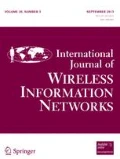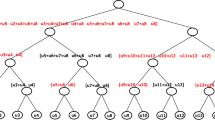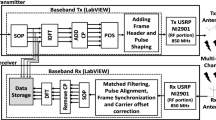Abstract
The full rate can be attained by the conventional Quasi-Orthogonal Space–Time Block Codes (QO-STBC) with the downside of more decoding intricacy and less diversity gain. Grammian matrix of already existing QO-STBC scheme contains non-diagonal elements i.e. interference terms which are responsible for more computational load at the receiver. The non-diagonal elements causing interference while decoding process are eliminated from the grammian matrix by the use of RAR (reflection and rotation) operations on the detection matrix of already existing QO-STBC. Reflection and rotation QO-STBC (RAR-QOSTBC) scheme is proposed in this paper, which results in transformation of the grammian matrix into a diagonal matrix. Corresponding to the diagonal matrix, a new RAR-QOSTBC encoding matrix is generated. RAR-QOSTBC scheme enables to achieve more diversity gain as well as it reduces decoding intricacy at the receiver as comparison to the already existing QO-STBC method. Analysis has been performed for different levels of PSK modulation over two distinct channels (AWGN and Rayleigh) by changing the number of receive antennas. Simulation result shows a significant improvement in the BER performance because of the removal of non-slanting elements from the detection matrix.



Similar content being viewed by others
References
S. M. Alamouti, A simple transmit diversity technique for wireless communications, IEEE Journal on Selected Areas in Communications, Vol. 16, pp. 1451–1458, 1998.
V. Tarokh, N. Seshadri and A. Calderbank, Space-time codes for high data rate wireless communication: performance criterion and code construction, IEEE Transactions on Information Theory, Vol. 44, pp. 744–765, 1998.
V. Tarokh, H. Jafarkhani and A. R. Calderbank, Space-time block codes from orthogonal designs, IEEE Transactions on Information Theory, Vol. 45, pp. 1456–1467, 1999.
V. Tarokh, H. Jafarkhani and A. R. Calderbank, Space-time block coding for wireless communication: performance results, IEEE Journal on Selected Areas in Communications, Vol. 17, pp. 451–460, 1999.
O. Tirkkonen, A. Boariu, and A. Hottinen, “Minimal non-orthogonality rate 1 space–time block code for 3 + Tx antennas”. In IEEE 6th International Symposium On Spread Spectrum Techniques And Applications, vol. 2, pages 429–432, 2000.
G. Ganesan and P. Stoica, Space–time block codes: a maximum snr approach, IEEE Transactions on Information Theory, Vol. 47, pp. 1650–1656, 2001.
M. Rupp, C. Mecklenbrauker and G. Gritsch, High diversity with simple space time block-codes and linear receivers, IEEE global conference on telecommunications (GLOBECOM), Vol. 1, pp. 302–306, 2003.
H. Jafarkhani, A quasi-orthogonal space-time block code, IEEE Transactions on Communications, Vol. 49, pp. 1–4, 2001.
W. Su and X. Xia, On space–time block codes from complex orthogonal designs, Wireless Personal Communications, Vol. 25, pp. 1–26, 2003.
C. Xu, Y. Gong and K. Letaief, High-rate complex orthogonal space–time block codes for high number of transmit antennas, IEEE international conference on communications (ICC), Vol. 2, pp. 823–826, 2004.
W. Su and X. G. Xia, “Signal constellations for quasi-orthogonal space–time block codes with full diversity,” IEEE Transactions on Information Theory, Vol. 50, No. 10, October 2004.
K. Lu, S. Fu and X. Xia, Closed-form designs of complex orthogonal space–time block codes of rates (k + 1)/(2 k) for 2 k − 1 or 2 k transmit antennas, IEEE Transactions on Information Theory, Vol. 51, pp. 4340–4347, 2005.
B. Badic, M. Rupp, and H. Weinrichter, “Quasi-orthogonal space–time block codes: Approaching optimality,”. In The 13th European signal processing conference (EUSIPCO), 2005.
U. Park, K. Lim and J. Li, A novel QO-STBC scheme with linear decoding for three and four transmit antennas, IEEE Communications Letters, Vol. 12, pp. 868–870, 2008.
Z. Q. Taha and A. K. Farraj, Efficient decoding for generalized quasi-orthogonal space-time block codes, Wireless Personal Communications, Vol. 68, pp. 1731–1743, 2013.
V. Sharma and S. Sharma, Noval linear decodable QO-STBC for four transmit antennas with transmit antenna shuffling, Wireless Personal Communications, Vol. 82, pp. 47–59, 2015.
G. H. Golub and C. F. Van Loan, Matrix Computations, vol. 3rd, Johns Hopkins University PressBaltimore, 1996.
S. Lang, Linear Algebra, vol. 2nd, SpringerNew York, NY, 1987.
A. S. Hedayat, N. J. A. Sloane and J. Stufken, Orthogonal Arrays: Theory and Applications, vol. 1st, SpringerNew York, NY, 1999.
Author information
Authors and Affiliations
Corresponding author
Rights and permissions
About this article
Cite this article
Chugh, S., Kansal, L. A Noval RAR-QOSTBC Scheme with Linear Decoding for M-PSK Over Diverse Channels. Int J Wireless Inf Networks 25, 108–115 (2018). https://doi.org/10.1007/s10776-017-0380-1
Received:
Accepted:
Published:
Issue Date:
DOI: https://doi.org/10.1007/s10776-017-0380-1




